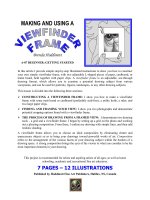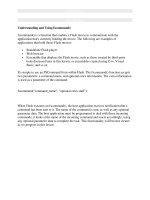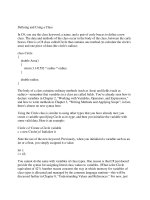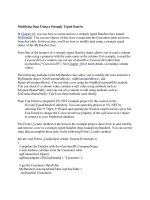Tài liệu Making and Using a Viewfinder Frame - Lập và Sử dụng một khung ngắm ppt
Bạn đang xem bản rút gọn của tài liệu. Xem và tải ngay bản đầy đủ của tài liệu tại đây (661.53 KB, 7 trang )
MAKING AND USING A
Brenda Hoddinott
A-07 BEGINNER: GETTING STARTED
In this article I provide simple step-by-step illustrated instructions to show you how to construct
your own simple viewfinder frame, with two adjustable L-shaped pieces of paper, cardboard, or
matte board, held together with paper clips. A viewfinder frame is an adjustable, see-through
drawing format, which allows you to examine a potential drawing subject from various
viewpoints, and can be used for portraits, figures, landscapes, or any other drawing subjects.
This lesson is divided into the following three sections:
Ü CONSTRUCTING A VIEWFINDER FRAME: I show you how to make a viewfinder
frame with some matt board or cardboard (preferably acid-free), a utility knife, a ruler, and
two large paper clips.
Ü FINDING AND FRAMING YOUR VIEW: I show you two photographs and demonstrate
potential cropping options found with a viewfinder frame.
Ü THE PROCESS OF DRAWING FROM A FRAMED VIEW: I demonstrate two drawing
tools – a grid and a viewfinder frame. I began by setting up a grid on the photo and working
out a pleasing composition. From there, I outline my drawing with simple lines, and then add
realistic shading.
A viewfinder frame allows you to choose an ideal composition by eliminating clutter and
unnecessary objects so as to bring your drawings toward powerful works of art. Composition
refers to the arrangement of the various facets of your drawing subject within the borders of a
drawing space. A strong composition brings the eyes of the viewer to what you consider to be the
most important elements in your drawing.
This project is recommended for artists and aspiring artists of all ages, as well as home
schooling, academic and recreational fine art educators.
7 PAGES – 12 ILLUSTRATIONS
Published by Hoddinott Fine Art Publishers, Halifax, NS, Canada
Copyright to all articles, images, text, projects, lessons and exercises within this drawing class belong to Brenda Hoddinott and
may not be reproduced or used for any commercial purposes whatsoever without the written permission of Brenda Hoddinott.
Web site or
- 2 -
CONSTRUCTING A VIEWFINDER FRAME
A viewfinder frame is an adjustable, see-through drawing format, which allows you to view a
potential drawing subject from various viewpoints. It’s an invaluable tool for planning a
composition, and can be used for portraits, figures, landscapes, or any other drawing subjects.
You can easily make a viewfinder frame with some matt board or cardboard (preferably acid-
free), a utility knife, a ruler, and two large paper clips. Acid-free describes a high quality, long
lasting, and ph balanced paper that has had the acid removed from the pulp in the paper-making
process. Drawings can be ruined when papers with acid deteriorate and turn yellow.
When buying matt board or cardboard, stay with neutral rather than bright
colors. When using a brightly colored viewfinder frame, your eye is grabbed by the loud
color and it’s hard to concentrate on the view inside its perimeter.
ILLUSTRATION 07-01
1) Use a ruler and a utility knife to cut
two identical L-shaped pieces of
cardboard.
When choosing a size, keep in mind
that the wider your frame, the more
distracting unwanted objects are
blocked from view.
ILLUSTRATION 07-02
2) Use two large paperclips to
join the two pieces of
cardboard together to form
a frame.
The frame can be adjusted so
as to be wider or narrower. It
can also be turned sideways
to help you choose either a
vertical (sometimes called
“portrait”) or a horizontal
(called “landscape”) drawing
format.
Through the adjustable
opening, you can examine
and evaluate the
relationships between the
lines, values, and shapes of
your subject.
Copyright to all articles, images, text, projects, lessons and exercises within this drawing class belong to Brenda Hoddinott and
may not be reproduced or used for any commercial purposes whatsoever without the written permission of Brenda Hoddinott.
Web site or
- 3 -
Consider making several viewfinders in three or four different sizes. Smaller
ones are great for planning compositions from photos. Bigger ones are ideal for finding a
composition when you are outside trying to choose a subject for drawing or painting.
FINDING AND FRAMING YOUR VIEW
An entertaining aspect of being an artist is that you can make any changes you wish to a photo
before you draw. Modifying an existing composition is easy with help from a viewfinder frame.
In this section I show you two photographs and demonstrate potential cropping options found
with a viewfinder frame.
ILLUSTRATION 07-03
3) Place your viewfinder frame on your photo
(or hold it up in front of your scene and look
through it).
Continuously adjust both sections until you find
a composition you like.
For example, the photo on the right was cropped
with a viewfinder frame to find the below
composition.
ILLUSTRATION 07-04
When
you choose a
composition you like,
mark the four corners
inside the viewfinder
frame with a small dot
so you know its
location after the
frame is removed.
The following
composition is also
selected with the help
of a viewfinder frame.
Copyright to all articles, images, text, projects, lessons and exercises within this drawing class belong to Brenda Hoddinott and
may not be reproduced or used for any commercial purposes whatsoever without the written permission of Brenda Hoddinott.
Web site or
- 4 -
ILLUSTRATION 07-05
Keep in mind that the
basic process for using a viewfinder
frame with a photo is almost
identical for viewing potential
drawing subjects from life.
Drawing from life refers to the
process of drawing from an actual
person, animal or scene, rather than
from a two dimensional photo or
sketch.
ILLUSTRATION 07-06
THE PROCESS OF DRAWING FROM A FRAMED VIEW
In this project I used two drawing tools – a grid and a viewfinder frame. I began by setting up a
grid on the photo and working out a pleasing composition. From there, I outlined my drawing
with simple lines, and then added realistic shading.
Copyright to all articles, images, text, projects, lessons and exercises within this drawing class belong to Brenda Hoddinott and
may not be reproduced or used for any commercial purposes whatsoever without the written permission of Brenda Hoddinott.
Web site or
- 5 -
ILLUSTRATION 07-07
First of all, I tape my photo to a sheet of graph
paper. I decide to tilt the photo slightly to make her
adorable face even more expressive, and the overall
composition more aesthetically pleasing.
ILLUSTRATION 07-08
With a fine tip ballpoint pen, I draw the horizontal
and vertical grid lines by using the lines of the
graph paper as guidelines. My graph paper has one
quarter inch squares.
ILLUSTRATION 07-09
I place my viewfinder frame on the photo, and
continuously adjust both sections until I find a
composition I like.
ILLUSTRATION 07-09 ILLUSTRATION 07-10
I then mark the corners of the photo so I
know how to identify the location of my
composition after the frame is removed.
The final step before drawing is to add
letters and numbers so I can keep track
of where I am working as I work.









